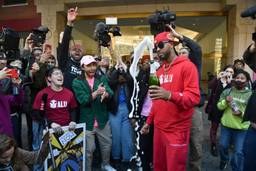Our Political System Is in the Midst of a Massive Realignment. Here’s How the Left Should Respond.
We have an opportunity to build a different kind of party.
Shaun Richman

America needs a New Democratic Party.
No, I don’t mean a Democratic Party made new by a restored commitment to liberal idealism (although that would be useful, too). I mean an American version of Canada’s NDP: an explicitly socialist party that can win on a regional basis, credibly compete on a national basis and actually win on issues that matter.
The leftist debate on electoral activism is depressingly reductive. It’s either be the “left-wing of the possible” within the Democratic party or immediately form a third party, as if we are not capable of sorting out complicated solutions for complicated times. We have a historic opportunity. Whether one realizes it or not, we are in the midst of a profound political realignment that could make a third party conceivable.
The right-wing realignment and its pull on the Democrats
A political realignment happens when the two main parties significantly alter their ideology and campaign appeal and in so doing shift their regional bases of support. They are rare. One happened when Roosevelt’s New Deal effectively wooed urban progressives away from the GOP, while preserving the Democrats’ traditional base of southern support (largely by avoiding black civil rights demands). For the next 36 years, the Democrats won seven out of nine presidential elections, and controlled the House and Senate for much of the period.
Nixon’s “Southern Strategy” tapped into reaction against the civil rights, women’s rights and anti-war movements and produced a new realignment. With the former Confederate states now solidly in the GOP column, and white working-class voters increasingly willing to cast reactionary votes for the party in the north, Republicans won seven out of 10 of the next presidential elections and have, since the mid-1990s, tended to control the House.
The Republicans’ crisis, and our opportunity, is that the party has been so captured by its base that it is circling the drain of national viability. The hateful, racist, misogynistic, xenophobic and just plain reality-denying rhetoric that the current crop of their presidential aspirants must use to pander to their troglodytic base makes them simply unelectable in a national contest.
Look at the demographics, as the Pew Research Center did earlier this year. The GOP alienates the majority of women voters, the vast majority of black and Latino voters and has all but lost the so-called millennial generation — voter groups that are an increasing proportion of the electorate.
More importantly, look at the so-called “big sort,” the geopolitical trend of people moving into or out of communities in order to be surrounded by more like-minded neighbors. Researchers James A. Thompson and Jesse Sussell found that the “big sort” is significantly contributing to the political polarization of Congress. Republican voters have created for themselves an echo chamber that goes beyond Fox News to include their like-minded neighbors. This contributes to the GOP reinforcing and doubling down on its extremism. It’s hard to imagine how the GOP can break this cycle any time soon.
Republicans can win — and win big — on a regional basis and implement awful policies. And to be sure, the Left should be concerned with keeping the Republicans out of national office. But the Republicans are going to do a good job of that themselves.
Meanwhile, the “big sort” leaves viable progressive majorities in our large urban centers and even entire states like California, Massachusetts, New York and New Jersey for the most part trapped in a Democratic party that will also continue to move to the right unless we do something about it. This realignment is pushing moderate and even conservative voters into the Democratic camp. There are, after all, plenty of stockbrokers and corporate executives who support gay marriage and immigration. The GOP is no longer a comfortable home for them — the Democrats are.
These progressive enclaves are increasingly a one-party political system, with the GOP’s carcass lying around as an empty vessel for whatever rich white guy wants to run a vampiric vanity campaign. And, sure, Republicans like Bruce Rauner and Chris Christie can win fluke elections when voters are so disgusted by the laziness and corruption of monopolistic Democratic machines that they stay home – or vote for nebulous “change” — in protest. But for the most part, there is a huge vacuum on the left in these progressive enclaves that should trump any tired liberal objections about “electability” and “lesser evils.”
An inside/outside strategy
What the Left needs is an inside/outside electoral strategy vis-à-vis the Democrats.
Inside the Democratic Party, engaged in primary campaigns to push progressive candidates and causes, because current election laws as well as fear of playing the spoiler mean that this is where we must focus out electoral energy for the time being if we are hold together the broadest possible coalition.
But outside in terms of being clearly delineated as something more specific: more critical of capitalism, more independent of corporations and more accountable to its base of supporters than being just another Democrat. And outside in terms of having a real plan to break with the Democrats and become a fully independent third party when the opportunity comes.
Inside/outside electoral strategies have long been incubated in New York state, where the law allows — and political realities demand — that candidates run on multiple ballot lines. Since 1998, the Working Families Party has been the preeminent inside/outside experiment on the Left. The WFP has an impressive track record of endorsing insurgent progressives early and backing them in the Democratic primary, as well as occasionally running a candidate in the general election against the Democratic nominee — a strategy that has put scores of new progressives in office across the state, culminating in the election of NYC Mayor Bill DeBlasio.
The Working Families Party has expanded to five more states plus the District of Columbia, although the inability to run a candidate on more than one ballot line makes the party’s efforts in those places somewhat less visible. In Illinois, unions like SEIU and the Chicago Teachers Union have formed an independent political organization called United Working Families, which supported Jesus “Chuy” Garcia’s insurgent challenge to Rahm Emanuel in Chicago’s technically non-partisan mayoral election. In Vermont, Bernie Sanders’ long run of successful independent runs for office has led to the creation of the Progressive Party, which represents over a dozen local, state and federal offices — a viable third party if ever there was one.
Add to that the various progressive caucuses in legislatures and councils — progressive Democrats and independents who work together to press their agenda within the larger Democratic caucus — and you have, essentially, an undeclared, disunited party within the party.
It is time to unite and declare it so.
What’s in a name?
What you stand for matters, but having a label and an identity of standing for the right causes matters perhaps more. Thanks to the realignment that is expanding the Democratic Party and turning it much more conservative, a “Democrat” can be anybody from Rahm Emanuel and Andrew Cuomo to Elizabeth Warren and Keith Ellison.
What the hell is a “Democrat” and what do they stand for? Without a clear distinction, a vote for a Democrat might as well be a vote for war, for police brutality and mass incarceration, for demonizing teachers and slashing pensions, for shipping jobs overseas and keeping the minimum wage low. An untapped constituency remains alienated from a progressive movement that suffers from guilt by association with the corporate Dems.
Further, a progressive Democrat — even one who runs with a Working Families-type endorsement — is susceptible to all of the pressure from party leadership for the corporate agenda that any other Democrat faces, with little accountability to a base of supporters that comes from public identification with a movement. Most people reading this can think of some maddening state legislator or alderman who’s only progressive when it doesn’t count.
Bernie Sanders jokes about how often he hears from supporters and constituents, “We always know how you vote, Bernie.” Because Sanders, famously, insisted on being registered in Congress as an “Independent,” even while he caucused with the Democrats, C-SPAN had to create a third “Independent” category for vote tallies, and so, yes, we all know how Bernie votes on an issue. As a result, Sanders’ voting record has been the most second-guessed and debated by the Left for a quarter century (even though there have been members of the House who were arguably to Bernie’s left).
By standing out as an “I,” Bernie was held much more accountable to the Left on a national level than any other Democrat. Working Families public officials need to stand out and caucus and have their votes recorded as “W,” not “D.”
Whether we settle on the name “Working Families,” call it the “Progressive Party” or borrow “New Democrats” from our friends to the north, we do need one name that stretches from candidacy to office-holding to everyday activism. And we need one party, coast to coast, that people join and pay dues, that has a national committee and that gets people in a room together in meetings, teach-ins, conventions and trainings.
What holds us back?
There is a regrettable deficit of trust when it comes to any sort of left unity effort. Movements unify when they are on the ascendency, which is not a position that the Left is used to being in. Plus, there is a long history on the Left of dissension, discord and split. Going bigger and broader brings the potential for the project to get out of control. And these efforts — United Working Families, the Progressive Party, the WFP — seem to be self-consciously designed to be small and manageable.
United Working Families is a good case in point. The organizers toyed with forming a chapter of the WFP, but ultimately decided to organize independently with complementary — yet distinct — branding. The WFP has since welcomed the UWF as an affiliate with seats on the national board. (What choice did they have? There’s no space for both organizations to operate in Chicago).
A united party would have to have a federated structure, with autonomous state parties and local clubs. But the resistance to the shared branding goes deeper than a structural concern. It can be read as a desire to not be tarnished by someone else’s mistake.
United Working Families was formed while the Working Families Party was grappling whether or not to endorse Gov. Andrew Cuomo’s re-election bid. The New Yorkers could have really used some tough love and advice from Chicago on the feasibility of cutting a deal with Cuomo. Regrettably, the Chicago organizers chose parochialism and keeping their distance over solidarity.
Another thing that holds us back is fear of playing the spoiler. Again, the value of an inside/outside strategy is holding together the widest possible coalition while we are inside the Democratic Party. To be clear, the risk of letting the now-far-right Republicans eke out a win if the center and Left were to split the vote in a general election is substantial. The Supreme Court, the right to choose, union rights and questions of war and peace are not to be dismissed lightly.
But a split must one day come. If the Republicans cease to be a major party in the northeast, on the west coast and in the major urban centers of the mid-west, and lose the next three or four presidential elections, then anyone who is still harping on about lesser evils or unity at any cost is probably simply not comfortable with a turn towards explicitly anti-capitalist politics.
I write of presidential election cycles because they are important epochal markers, not because we should fritter away our time debating when to make a break and run a Nader-style third party campaign. Look, I get it. Presidential elections are years when more working people actually pay attention to mainstream politics and vote, so what we do and whom we’re supporting is big and symbolic. But big changes in social outlook and political policy are ratified in presidential elections. The changes are made more gradually and much more locally. Our challenge for the next decade and a half is to run Working Families campaigns for legislature, council and Congress and win; to build up a base that makes for “safe” Working Families districts; and to build Working Families legislative caucuses that put real pressure on the corporate Dems.
Some of this can be accomplished, as the Progressive Party seems to have done in Vermont, through a degree of brokering. The Progressives build up enough of a base in a district that they hold the plurality, and the Democrats decide not to run a strong candidate against them. I presume that the Progressives agree in exchange to not make a hard run at a district where the Democrats hold the edge. In this way, a center-left split doesn’t have to be a 100% spoiler effort.
The ultimate split may, indeed, be signaled by an independent presidential campaign. I’m getting many years ahead of myself here, but let me suggest that the timing would only be right if our new party posed a credible threat of actually winning some electoral votes. Could we pose enough of a threat of throwing the election into chaos to extract meaningful election reforms — like abolishing the electoral college and instituting instant runoff voting — to make “spoilers” a thing of the past?
Our big challenge right now, though, is whether we are bold enough to actually get in a room and hammer out a program, a structure and a common name.
The Sanders presidential campaign is a very timely opportunity. Whether Bernie wins the Democratic nomination (still a distinct possibility) or takes his delegates and forces a convention fight over the Democratic Party’s platform, that platform will be the highest profile list of “Left” demands in generations. It will arouse the interest and support of many thousands times more working people than currently number in our tiny movement. What those freshly inspired potential activists will need is to see a party that they can join that will work past the election on winning those demands.
We have a historic opportunity in 2016. Shame on all of us if we don’t recognize the opportunity and capitalize on it.
Shaun Richman is a labor expert at SUNY Empire State University and author of Tell The Bosses We’re Coming: A New Action Plan for Workers in the 21st Century.








